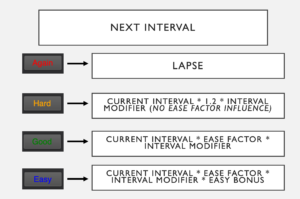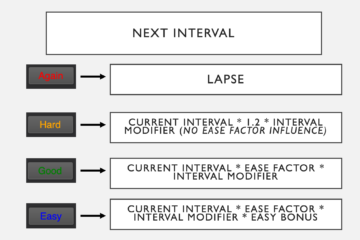
With the default Anki behavior, we can see a card, hit on it, and then immediately hit if there are no other cards we’re studying at the time.Ĭlick on a deck and hit the cog at the right of it. In Anki, go to Tools>Preferences>Basic, then set the Learn ahead limit to 2mins Usage: Just hit Tools>Reset EaseUse this addon ASAP because it will fix the intervals on your old/recent cards, and start giving you less reps! Your new cards will be fine, but this can fix your old cards a bit so that they start increasing more quickly again. resetEZ – reset the ease on all your Anki cards – Link It fixes a common gripe people have with how Anki prioritizes cards.Ĥ. It basically improves how Anki handles showing new cards, so that you’re able to simultaneously review and see new cards as you rep. put ALL due -learning- cards first × – Link this basically fixes the aspect of the Hard button making cards appear early, as well as removing the easy bonus from hitting the Easy button.ģ. Low Stakes Anki: No Penalties or Boosting – Link Also, we can increase the standard interval increasing.Ģ. The number of revisions, or times we see a card, is what improves this, but we shouldn’t be drastically reducing the interval increase by hitting Hard all the time. The reality of a card feeling “hard” or “easy” and us judging the difficulty ourselves is actually really arbitrary.

this changes Anki’s behavior so that we simply answer Yes or No for our cards.
OPTIMIZED ANKI SETTINGS INSTALL
Part 1: Install these Anki Addons for Anki on PC So how do I fix this and make better gains?! With this setting tweak, you can have Anki enforce these times, which generally gets you to learn your cards better. If you study a new card in Anki and hit “20 minutes” on it, and then finish up all your reps, Anki will show you that new card again and let you hit “1 day” on it even if it hasn’t hit 20 minutes. This behavior is a bit complicated to explain, but here it goes. If you fail a card after 15 days, instead of resetting back to 1, you get the option of hitting 15 days again, and then after 15 days, getting to go up to 39 days.ĪNOTHER Tweak: No finishing off cards early Let’s look at the earlier example of 1 day -> 2 days -> 6 days -> 15 days-> 39 days. High intervals won’t work as well for disconnected information, like random Jeopardy facts.Īdditionally, when you fail a card, you don’t have to completely reset it. Japanese will get easier to retain as you go, because the learning process is cumulative. This means that the more cards you’re doing, the easier each card becomes. Japanese is cumulative, so your sentence cards will contain words and parts of words that other sentences have. Why we can benefit from bigger interval increases: If you hit the Hard button, the rate decreases to a 2.25x it’ll look more like this:ġ day -> 2 days -> (Hard) 4 days-> 9 days-> 20 days -> 45 days. (The numbers get rounded down to the nearest whole number) If you always hit “Good” in Anki, your intervals will increase at a 2.5x like this:ġ day -> 2 days -> 6 days -> 15 days-> 39 days -> 97 days. Also, hitting the Hard button makes the card appear more often in the long run. It’s something like a difficulty multiplier that gets permanently attached to your card. Ok, so I realized that there’s actually a ton to explain, and I could probably make a 20 minute video just about why this is so beneficial, so I’m working to trim it down a bit.Ĭurrently, whenever you fail a card, Anki will make a card appear more often than before, by tweaking the interval rate. Here’s the gist of this radical shift to Anki that will make learning much less frustrating: Anki is supposed to be a tool you use to improve your learning, not something you hate and struggle to use. You want to make real gains, but you can’t imagine doing more than 20 or 30 new cards/day, can you? After all, you keep hitting “Hard” on yesterday’s vocab, and it’s just not sticking. Make sure to use the Reset Ease tool (Tools> Reset Ease) to fix all your old Anki cards!Īnki hasn’t been treating you right. Before reaching the graduated interval, cards are in the learning phase, which allows more leniency towards choosing again or hard because ease factor will not be applied.Watch the video for the new quick setup and instructions: かっこいい動画(笑).Graduated interval: when ease factor adjustments begin to take place based on choosing again, hard, or easy (choosing good does not change ease factor). Anki Settings: A Complete Guide and Recommended Settings For Medical School - YouTube.



 0 kommentar(er)
0 kommentar(er)
